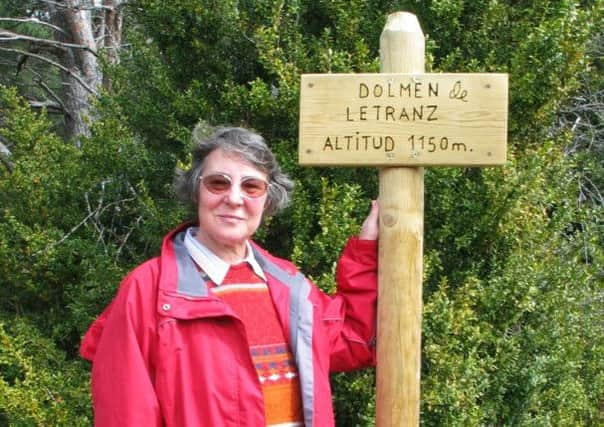Obituary: Prof. Magdalena Midgley, professor of archaeology at the University of Edinburgh


Magdalena Appelt was a talented young Polish schoolgirl whose desire to improve her English was the stepping stone to a career as an internationally renowned archaeologist.
Just 19 when she took the opportunity to visit relatives in Scotland to brush up on the language, she was soon introduced to the man who would become her husband. With his support she embarked on a learning curve that would ultimately lead her to a professorship at the University of Edinburgh.
Advertisement
Hide AdAdvertisement
Hide AdAs an expert in the European Neolithic she not only enthused and inspired her students with her knowledge of, and unending curiosity for, megalithic monuments, but she was a skilful administrator and a naturally compassionate pastoral carer over almost 25 years.
The daughter of an industrial designer, Bruno Appelt, and his wife Bronislawa, she was born and brought up in the northern Polish city of Bydgoszcz, where she was educated locally until leaving high school in 1971.
However, the previous year a chain of events had been put in motion that would see her find personal and professional fulfilment in Scotland for the rest of her life.
While still at school, where she was taught English, she met her cousin Bernard who had returned to visit family after having escaped Poland during the Second World War. Bernard, who joined the British Army after being liberated from German captivity by British troops, had settled in Edinburgh with his Scottish wife Kathleen.
The couple hit it off with Magdalena, who was already a competent linguist and, as the only English-speaker in the family, acted as Kathleen’s translator. They invited her to the Scottish capital and, keen to improve her English, the teenager took up their offer.
She arrived in Edinburgh in 1972 and embarked on an English course at the city’s Stevenson College while also doing some work as an au pair. That October she met modern languages teacher Stephen Midgley, at a birthday party at his flat, and fell in love.
They married in Edinburgh the following May.
Encouraged by her husband and family she continued her studies, gaining enough Highers to win a place at Edinburgh University in 1974.
Her chosen field was archaeology, a subject that, along with history, had interested her since childhood. Inspired by one of her tutors, Professor Stuart Piggott, one of the most distinguished archaeologists of his generation and an expert on the Neolithic period, she was soon specialising in prehistoric archaeology, with a particular interest in the northern and central European Neolithic.
Advertisement
Hide AdAdvertisement
Hide AdAfter graduating MA Hons in 1978, she was awarded a PhD for her research on north European earthen long barrows, or Neolithic tombs, in 1985.
Over the next few years she took part in various archaeological excavation projects and was appointed a lecturer in prehistoric archaeology at Edinburgh University in 1989.
She mainly taught and researched the early farming cultures of Europe, publishing numerous papers, particularly on the funerary monuments – especially the earthen long barrows – of the North European plain and adjacent areas.
She also participated in excavations from the Czech Republic to Burgundy and east-central Scotland and her fieldwork took her from the Spanish Pyrenees to southern Scandinavia and the forests of her native Poland.
In addition she was producing several books: TRB Culture: The First Farmers of the North European Plain; The Monumental Cemeteries of Prehistoric Europe and The Megaliths of Northern Europe.
Magda, as she was known at the university, was also quality assurance adviser to the old faculty group of arts, divinity and music for several years, and was an integral member of the school in its new home in the Old Medical Building.
She was promoted to a personal chair of the European Neolithic, in the school of history, classics and archaeology in August 2013 but retired on health grounds in June this year after being diagnosed with cancer 18 months ago.
A member of the Society of Antiquaries, she was particularly interested in the early antiquarians of the 18th century and, although unable to teach for the past year, had been very actively researching the early history of archaeology and its relation to romanticism, a sphere that fascinated her.
Advertisement
Hide AdAdvertisement
Hide AdShe had also previously done the groundwork to establish a major collaborative project examining the country’s prehistoric monuments, Neolithic Scotland: Making Monuments, Creating Communities, in which she would have been expected to play a leading role.
Though she never returned to live in Poland, she visited many times and kept in touch with family and events in her birthplace. She and her husband shared many passions, among them cats, classical music and fast cars. She loved literature, walking in the mountains and travelling, particularly to their holiday home in the Pyrenees.
A very distinctive personality, who could express her forthright views eloquently and without dogma, she was a lively advocate of the issues in which she believed and a supporter of many animal welfare charities.
Colleagues and former students alike remember a clever, candid, warm and engaging woman who was always determined to do what was right and fair for all concerned and who will be enormously missed by a wide swathe of the profession.
In the words of one admirer: “She was amazing and helped me have passion for my interest in archaeology and the world. It is a less sparkling place now.”
Professor Midgley is survived by her husband Stephen and sister Krystyna.
ALISON SHAW